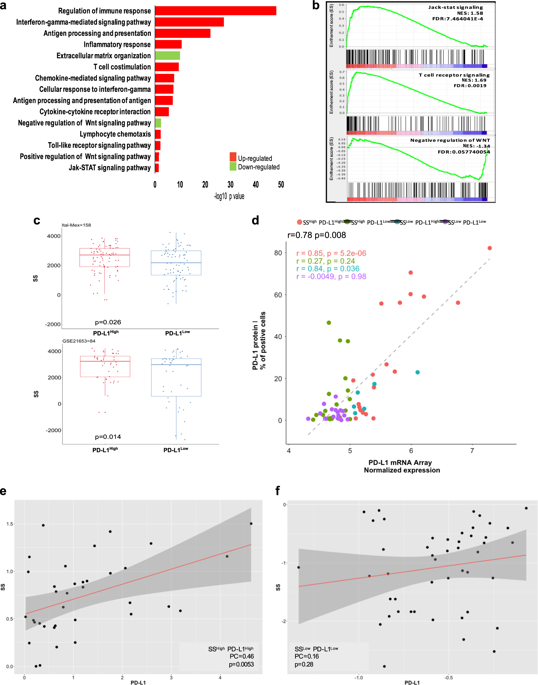Oncogene ( IF 6.9 ) Pub Date : 2019-01-31 , DOI: 10.1038/s41388-019-0700-2 Lorenzo Castagnoli , Valeria Cancila , Sandra L. Cordoba-Romero , Simona Faraci , Giovanna Talarico , Beatrice Belmonte , Marilena V. Iorio , Matteo Milani , Tatiana Volpari , Claudia Chiodoni , Alfredo Hidalgo-Miranda , Elda Tagliabue , Claudio Tripodo , Sabina Sangaletti , Massimo Di Nicola , Serenella M. Pupa

|
Triple-negative breast cancers (TNBCs) are characterized by a poor prognosis and lack of targeted treatments, and thus, new therapeutic strategies are urgently needed. Inhibitors against programmed death-1 (PD-1)/PD-1 ligand (PD-L1) have shown significant efficacy in various solid cancers, but their activity against TNBCs remains limited. Here, we report that human TNBCs molecularly stratified for high levels of PD-L1 (PD-L1High) showed significantly enriched expression of immune and cancer stemness pathways compared with those with low PD-L1 expression (PD-L1Low). In addition, the PD-L1High cases were significantly associated with a high stemness score (SSHigh) signature. TNBC cell lines gated for aldehyde dehydrogenase (ALDH) and CD44 stemness markers exhibited increased levels of PD-L1 versus their ALDH-negative and CD44Low counterparts, and PD-L1High cells generated significantly more mammospheres than PD-L1Low cells. Murine mammary SCA-1-positive tumor cells with PD-L1High expression generated tumors in vivo with higher efficacy than PD-L1Low cells. Furthermore, treatment of TNBC cells with selective WNT inhibitors or activators downregulated or upregulated PD-L1 expression, respectively, implying a functional cross-talk between WNT activity and PD-L1 expression. Remarkably, human TNBC samples contained tumor elements co-expressing PD-L1 with ALDH1A1 and/or CD44v6. Additionally, both PD-L1-/SCA1-positive and ALDH1A1-positive tumor elements were found in close contact with CD3-, and PD-1-positive T cells in murine and human tumor samples. Overall, our study suggests that PD-L1-positive tumor elements with a stemness phenotype may participate in the complex dynamics of TNBC-related immune evasion, which might be targeted through WNT signaling inhibition.
中文翻译:

WNT信号调节三阴性乳腺癌干细胞区室中PD-L1表达
三阴性乳腺癌(TNBC)的特点是预后差且缺乏针对性治疗,因此迫切需要新的治疗策略。针对程序性死亡1(PD-1)/ PD-1配体(PD-L1)的抑制剂已在多种实体癌中显示出显着功效,但它们对TNBC的活性仍然有限。在这里,我们报道了高水平的PD-L1(PD-L1高)分子分层的人TNBC与低PD-L1表达(PD-L1低)的人TNBCs相比,免疫和癌症干性途径表达显着丰富。此外,PD-L1高病例与高干度评分显着相关(SS高) 签名。选通醛脱氢酶(ALDH)和CD44干性标记的TNBC细胞系显示PD-L1水平高于其ALDH阴性和CD44 Low对应物,而PD-L1 High细胞产生的乳球明显多于PD-L1 Low细胞。PD-L1高表达的鼠乳腺SCA-1阳性肿瘤细胞在体内产生肿瘤的功效高于PD-L1低细胞。此外,分别用选择性下调或上调PD-L1表达的选择性WNT抑制剂或激活剂处理TNBC细胞,意味着WNT活性和PD-L1表达之间存在功能性串扰。值得注意的是,人TNBC样品含有与ALDH1A1和/或CD44v6共表达PD-L1的肿瘤成分。另外,在鼠和人肿瘤样品中,发现PD-L1- / SCA1阳性和ALDH1A1阳性肿瘤元素均与CD3和PD-1阳性T细胞紧密接触。总体而言,我们的研究表明,具有干性表型的PD-L1阳性肿瘤成分可能参与了TNBC相关免疫逃逸的复杂动态,这可能是通过WNT信号抑制来靶向的。











































 京公网安备 11010802027423号
京公网安备 11010802027423号